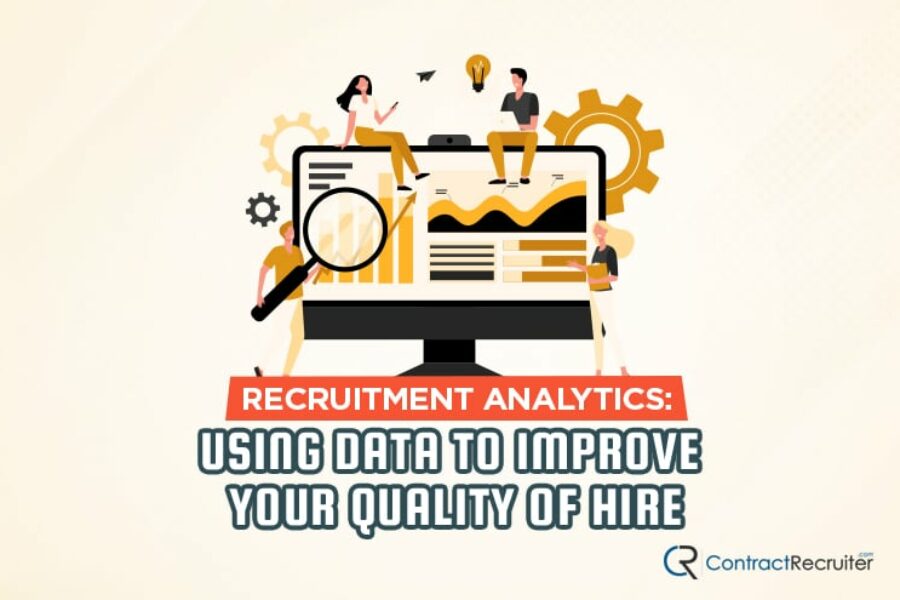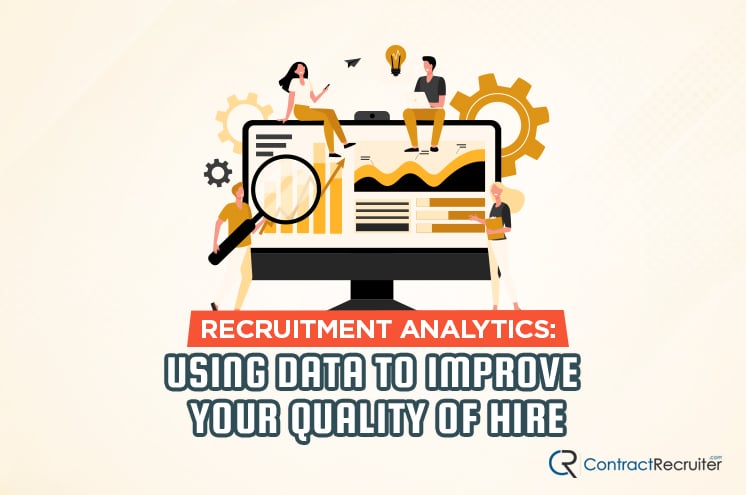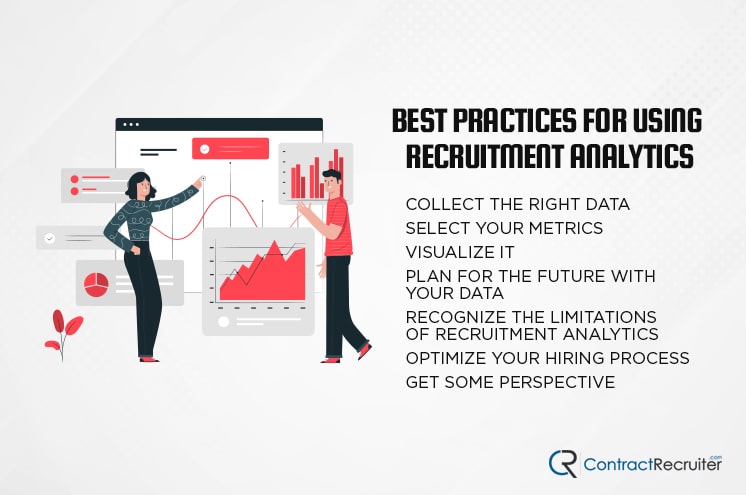The people that make up an organization are perhaps the most critical factor in its success. Every day, personnel at a company make countless decisions and actions that help determine whether a business grows or struggles.
For this reason, hiring decisions are crucial for businesses to get right. When you select a high-quality candidate for a position, it means that they have the potential to increase the success and effectiveness of the organization as a whole.
One of the ways that modern companies are making their hiring process more efficient and effective is with the use of recruitment analytics.
What are recruitment analytics, and how can they benefit your recruitment process? How can you use data to improve your quality of hire?
What Are Recruitment Analytics?
Recruitment analytics is the application of big data analytics to the hiring process. Allowing your recruitment team to measure and adjust its strategy based on collected data, recruitment analytics can help you make better, more efficient hiring decisions.
This type of software can help identify patterns that emerge in your recruitment data. For example, your analytic software might discover that new hires commonly leave the organization only after two months. This could point toward issues in the onboarding process, candidate selection, or the job description.
As you might imagine, this data analysis can completely revolutionize your hiring process. There are tons of essential questions that can be answered by recruitment analytics, including:
- What channels are producing the best candidates?
- What similarities do my best candidates share?
- What is the total cost of hiring for a new position?
- At what stage in the recruitment process do most prospective hires drop out?
Recruitment analytics can draw data from many different sources. Commonly, customer relationship management (CRM) systems, applicant tracking systems (ATS), and human resources information systems (HRIS) are used as data sources. Additionally, this software can use information from satisfaction surveys, job advertising platform data, and brand data.
Another way that hiring teams use technology to improve their recruitment process is through the application of software that helps to facilitate blind recruitment. Also known as anonymous hiring, blind recruitment tools can help avoid unconscious bias and improve efficiency.
How Can Data Improve Your Hiring Process?
Your hiring efforts can be significantly improved by recruitment analytics. By making data-driven hiring decisions, you can keep your hiring process competitive, make better hiring decisions, and help your organization succeed and grow in the long run.
When you utilize recruitment analytics, you track, measure, and analyze data from existing employees and prospective candidates. Let’s take a look at how collecting and scrutinizing this data can improve your hiring process.
1. Improve the Quality of Your Hire
Perhaps one of the most compelling reasons an organization might want to use recruitment analytics in their hiring process is that it can improve the quality of your hire. These methods will allow you to better identify the top candidates for any given position, explore the skills and qualities that your best hires share with one another, and gather data to help inform an even better and more efficient decision in the future.
This means that when you have open roles in your organization, you will be increasingly able to match the right candidate with the right position. This can help reduce turnover, improve employee morale, boost productivity, and help to create a healthy and positive company culture.
2. Tracking Performance
You can also compare your performance against your recruitment KPIs and industry standards. This means that your recruiting team can become increasingly efficient over time as they can optimize their workflow and find areas where improvements can be made.
3. Boosting Efficiency
Hiring the right candidate for a position can be extremely time-consuming. That being said, there’s a good chance that inefficiencies and bottlenecks in your hiring process are difficult to see without using recruitment analytics.
This doesn’t just mean that you’ll be able to find the right candidate more quickly and with a smoother workflow, but it also means that it will cost less to hire each new employee.
4. Allowing For Future Forecasts
If you only start to look for new candidates when an existing employee gives their notice or receives a promotion, it means that you don’t have the same competitive edge as many other more proactive organizations. While it can be challenging to predict the future, you can use recruitment analytics to help anticipate gaps that will emerge in organizational skills and talent.
Similarly, this type of data analytics can help you create a plan for the next year or next five years regarding the cost per hire, time to hire, frequency of hire, and overall budget for the recruitment process.
5. Improving Diversity
Many HR departments are focused on and committed to improving diversity in their organization. While doing so can present unique challenges to companies, recruitment analytics can help them meet their diversity goals.
Gathering and analyzing hiring data can allow recruiting teams to keep track of their diversity initiatives and identify where alterations can be made to create more desirable outcomes.
There are numerous ways that analytics can be used to help your team ensure that the organization is adequately diverse. For example, you can examine each stage of the recruitment funnel with a complete demographic report.
Increasing generational diversity in the workplace is a significant focus for many hiring teams and HR departments. You can learn more about how to confront age bias in this guide.
6. Optimizing the Cost of Recruiting
We all know that the hiring process isn’t cheap, but it’s well worth the cost when you find the perfect hire for an open position. When you’re able to make well-informed recruiting decisions, the candidates you select will be well-suited for the role, will remain with the organization for some time, and will help contribute positively to the company culture.
The more effective your recruiting process is, the less you will have to spend overall on your hiring budget. Through data analytics, you’ll also be able to see which channels produce the highest-quality candidates and which haven’t been particularly useful for your organization.
As you might imagine, this means you can allocate your resources in the most productive direction for your organization. Your hiring team can work smarter, not harder, when filling open positions at the company, which means you can reduce spending on the hiring process over time.
How Can Data Improve Your Quality of Hire?
While the quality of hire might sound like a somewhat subjective metric, recruitment analytics can help pinpoint how much value new hires add to your organization. The baseline criteria for a hire to be considered a quality hire is that they create more value while employed at your brand than how much it costs to recruit and hire them.
This measure is often used to determine how successful a new hire becomes in their role at the company. However, recruiting teams can also use this metric to look at the overall success of recruitment as well.
If you’re only looking at the quality of hire on an individual basis, you are losing out on valuable information that could help improve the hiring process and quality of hire on an organization-wide basis. When you analyze the quality of hiring on a larger scale, you’ll notice that patterns start to emerge that you can use to improve your hiring process further.
Through recruitment analytics, you can keep track of how many of your hires become top performers, how long new hires typically stay with the organization, and more.
Recruitment analytics can collect historical data regarding your candidates and your recruiting metrics. That doesn’t just mean that you’ll be better able to identify the right candidate when they come to you, but it also means that you’ll be more equipped to transition to a proactive recruiting strategy.
A critical aspect of having a proactive recruiting strategy is understanding the difference between active and passive candidates. This article takes a deep dive into what you need to know about these different types of prospective employees.
Best Practices For Using Recruitment Analytics
Whenever you’re collecting data for your organization, there are practically an infinite number of ways that you can organize and analyze the information. Let’s take a look at some of the best practices for using recruitment analytics.
1. Collect the Right Data
Understanding your goals in using recruitment analytics can help you pinpoint the most useful data to collect in the process. Data collection gets more useful the longer the timeframe you’re working from– the more information you have to analyze, the more you’ll be able to identify persistent trends.
2. Select Your Metrics
Some of the most tracked recruiting metrics by organizations using recruitment analytics include cost per hire, time to hire, and retention rate. Companies might also choose to track the quality of hire, candidate quality, application completion rate, and more.
3. Visualize It
Another built-in challenge with recruitment analytics is making sense of all the data you collect. While it’s great to be tracking the right data and metrics, it can be frankly overwhelming to try and understand what all of these numbers mean for your hiring process.
One of the most valuable things you can do at this stage is to use visualization tools to better grasp the information and patterns hidden in your data.
Visualization can help you identify easy opportunities to improve your hiring process and also spot trends.
4. Plan For the Future With Your Data
Being able to plan for the future can give your organization an edge. If you cannot make predictions grounded in data about the future, you’ll be stuck in the position of always being reactive rather than proactive.
With predictive analytics, you can make an educated assessment of how much money you will need to hire a new candidate, how much time it will take to fill a specific role, which sources have historically produced the highest quality candidates, and more.
5. Recognize the Limitations of Recruitment Analytics
While recruitment analytics can be a revolutionary tool in your hiring process, it’s essential to recognize that this technology has its limitations. There will always be fewer quantitative factors that impact the job market that you might not be able to pick up on from simply looking at the data. For this reason, it’s important to incorporate data analytics into a larger recruitment process instead of solely relying on this technology as an all-inclusive strategy.
6. Optimize Your Hiring Process
Once you have collected enough data to start seeing trends in your hiring process, the next step is to use that data and analysis to optimize your recruitment strategy.
For example, your analytics might help you discover that your turnover rate is higher than desired. While recruitment analytics can help you identify this problem, you must take actionable steps to solve the problem. One of the best things about using data in the hiring process is you can use these tools to get quantifiable results regarding whether the steps you’re taking are improving recruitment at your organization.
By gathering actionable insights from your recruitment data, you can optimize your hiring efforts by making meaningful changes.
7. Get Some Perspective
As you continue to collect and analyze recruitment data over time, it’s essential to zoom out to grasp a larger perspective on your hiring process. It can be easy to have tunnel vision when you’re focusing on filling specific open positions or positions that you anticipate will need to be filled in the near future.
Your hiring team can benefit significantly from the longer-term analysis. This means tracking progress both month over month and year over year. You can then use this information to compare your progress against industry standards and your organizational and recruitment goals.
Is your organization using recruitment analytics to improve your quality of hire? Did we leave anything out about how data can make the hiring process more effective and efficient? If so, please feel free to leave a comment below, and we’ll get a conversation started! We’d be more than happy to discuss the topic further if need be!






